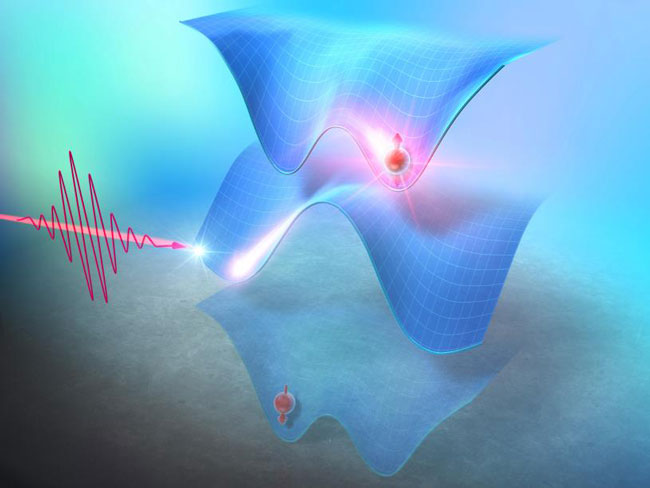Release content has been edited for accuracy. [2 December 2024]
Kyoto, Japan -- Generally you can't gain something without losing something else. But a team of scientists in Japan has discovered that the direction of spins inside a special type of magnet can be changed rapidly -- flipping about every trillionth of a second -- without increasing the temperature. They pulled this off by applying a strong magnetic field with an oscillation frequency in the terahertz range.
What's pushing this research? The ever-increasing amount of information handled by computers and communication devices is driving development of technologies using the terahertz band -- around 1012 Hz, a frequency range beyond the conventional gigahertz range of 109 Hz -- considered important for the post-5G era.
Additionally, memory technologies based on spintronics are expected to use less power to store more information, with antiferromagnets attracting attention because their collective spin-motion mode frequency reaches the terahertz range, making it possible to control spins using terahertz waves. However, conventional spin excitation using electric-field pulses is accompanied by heating or carrier excitation effects that subside relatively slowly, making it difficult to achieve fast spin control.
Writing in Nature Materials, a team of scientists led by Kyoto University has now demonstrated non-thermal spin switching in a canted antiferromagnet by dynamically modifying the magnetic energy landscape using a strong multicycle terahertz magnetic near-field.
"Antiferromagnets are expected to enable the realization of spintronic devices that operate faster than those based on ferromagnets," explains group leader Hideki Hirori.
Together with PhD student Zhenya Zhang, Hirori and the team used a metallic metamaterial structure fabricated on the surface of the antiferromagnet Sm0.7Er0.3FeO3 to strongly enhance the magnetic component of a terahertz wave inside the antiferromagnet. This led to their discovery that a terahertz magnetic field exceeding 1 Tesla can change the spin direction in Sm0.7Er0.3FeO3 very quickly.
To monitor the orientation of the macroscopic magnetization, the team tracked the time evolution of the polarization of an infrared probe light. They found that the shape of this time evolution strongly depends on the terahertz magnetic field strength, revealing that, at field strengths above 1 Tesla, a long-lived polarization offset signal appears after an initial short oscillation. This threshold behavior indicates that the overall spin orientation in the probed volume has changed to a direction different from that of the initial stable state.
Hirori adds, "We have shown that the antiferromagnetic mode, which is a particular type of spin motion, is initially excited by the terahertz magnetic field, and that the coupling between the antiferromagnetic mode and the ferromagnetic mode leads to a further dynamic modulation of the magnetic energy landscape in this material."
"We also expect that further discoveries related to magnetic Floquet states will lead to the development of new magneto-optical devices in the future."

【DOI】
https://doi.org/10.1038/s41563-024-02034-4
【KURENAI ACCESS URL】
http://hdl.handle.net/2433/293530
Zhenya Zhang, Minoru Kanega, Kei Maruyama, Takayuki Kurihara, Makoto Nakajima, Takehiro Tachizaki, Masahiro Sato, Yoshihiko Kanemitsu, Hideki Hirori (2025). Spin switching in Sm0.7Er0.3FeO3 triggered by terahertz magnetic-field pulses. Nature Materials, 24, 2, 219–225.





